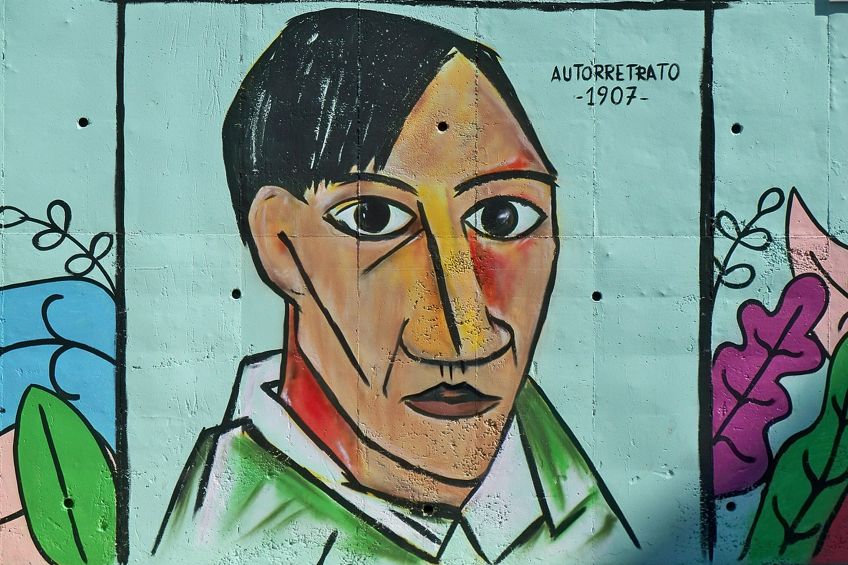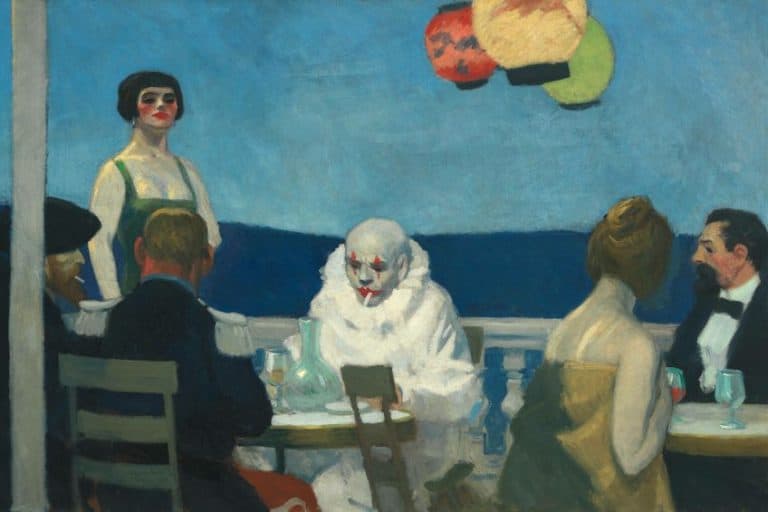“Le Rêve” by Pablo Picasso – The Dream Painting Analysis
Le Rêve (1932), which means “the dream” in French, is one of Pablo Picasso’s famous portrait paintings of his mistress, Marie-Thérèse Walter. It has been described as “erotic”, reportedly painted in one day, and was sold for over $150 million in 2013. This article will discuss this important Picasso painting in more detail below.
Artist Abstract: Who Was Pablo Picasso?
Pablo Ruiz Picasso was born on October 25, 1881, and died on April 8, 1973, in Málaga in Spain. He was an artist of many talents working in modalities like painting, printmaking, sculpture, and ceramics among others. His artistic oeuvre has been best understood in phases with the widely held date ranges assigned, namely his Blue Period (1901 – 1904), Rose Period (1905 – 1906), Primitivism (1907 – 1909), Cubism (1907 – 1925), Neoclassicism and Surrealism (1921 – 1937), and his War periods and later life (the 1930s to 1973). He had two marriages and several affairs throughout his life; he was known for having complex and passionate relations with the women in his life. Some of his popular artworks include Portrait of Gertrude Stein (1905), Les Demoiselles d’Avignon (1907), and Guernica (1937).
 Pablo Picasso (1962) by Revista Vea y Lea; Argentina. Revista Vea y Lea, Public domain, via Wikimedia Commons
Pablo Picasso (1962) by Revista Vea y Lea; Argentina. Revista Vea y Lea, Public domain, via Wikimedia Commons
Le Rêve (1932) by Pablo Picasso in Context
The Le Rêve painting analysis below will be divided into two sections, starting with a brief contextual analysis of Pablo Picasso’s motivations for painting it and what he experienced during that time period. This will be followed by a formal analysis, gazing more closely at the subject matter and understanding Picasso’s art style as categorized by the main art elements.
| Artist | Pablo Ruiz Picasso |
| Date Painted | 1932 |
| Medium | Oil on canvas |
| Genre | Portrait painting |
| Period / Movement | Cubism/Neoclassical/Surrealist |
| Dimensions (cm) | 130 x 97 |
| Series / Versions | N/A |
| Where Is It Housed? | Part of a private collection belonging to Steven Cohen |
| What It Is Worth | Steven Cohen bought it for $155 million in 2013 |
Contextual Analysis: A Brief Socio-Historical Overview
Le Rêve or The Dream painting was completed in 1932, which was several years after he met Marie-Thérèse Walter, who was not only his muse but also his mistress. The couple met in Paris in 1927 while Picasso was married to Olga Khokhlova.
Their affair was also a catalyst that shifted Picasso’s artistic style from angular and dissected Cubist renditions to curvatures and organic figures. Picasso’s art style has largely been associated with his Cubist phase (Analytical and Synthetic), and to this day if you think of Cubism, you think of Pablo Picasso.
However, he explored beyond the Cubist parameters, before and after Cubism. He created artworks within a Neoclassical and Surrealist style, which The Dream painting is also believed to emulate including Fauvist influences.
During the 1910s, Picasso drew influence from classical art when he visited Italy, and he incorporated a more naturalistic approach to his subject matter, an example from his Neoclassical period includes Two Women Running on the Beach (The Race) (1922), which illustrates his focus on the figurative, notice also the voluptuousness of his figures here.
It was not only the classical principles that Picasso revived in his paintings but also Surrealism, which he delved into in the early 1920s. However, he did not remain within this art style, but drew aspects from it, and was involved in exhibitions.
Reportedly, the pioneer of Surrealism, André Breton, also had an appreciation for Picasso’s artworks.
An example of one of Picasso’s surrealist paintings includes his oil on canvas La Fenêtre Ouverte (1929), which depicts the artist himself and Marie-Thérèse Walter as abstracted configurations; Picasso is to the left as two feet attached to a leg with an arrow intersecting through the middle of the leg. The ball of his bottom foot slightly rests on a larger circular ball-like object, elevating him compared to the figure of Walter, who has an angular face on top of a straight arm-like structure with a hand at the bottom that appears to be holding onto a smaller ball-like object. Walter can be identified by her hairstyle.
Formal Analysis: A Brief Compositional Overview
The Le Rêve painting analysis will start with a visual description of the subject matter and then a look at how Picasso created the composition in terms of the elements of art like color, texture, line, shape, form, and space.
Discussing how the art elements are utilized will also illustrate how Picasso conveyed his unique style of “distorting” the visual appearance of his subject matter, in this case, the portrait of Marie-Thérèse Walter.
Subject Matter: Visual Description
Le Rêve by Pablo Picasso depicts a blond woman reclining, and sleeping, in a red armchair in the foreground. Her head is tilted to her right (our left) and almost leaning on her right shoulder. The latter is propped higher than her left shoulder while both her elbows are rested on the armchair’s sides. Her hands are rested on her lap with intertwined index and middle fingers and placed in a way that resembles her genitalia.
She appears to be in a state of tranquillity, with a softened smile on her face and a relaxed body posture. There appears to be a split in her face, starting from between her eyes and moving down to below her lips. This split also divides her face into two parts, of which the part on the right resembles the shape of a penis.
There is a red and yellow beaded necklace following the natural curves around her neck and upper shoulders, disappearing behind her back. She appears to be wearing a white and light green dress or blouse, of which straps have fallen over her upper arms, just above her elbows, and its looseness reveals part of her left breast. The background depicts an interior setting, what appears to be a deep green wall with panels to the left and what is possibly a red curtain or tapestry with squares and floral patterns on it hanging to the right.
Texture
There is a smoothed surface texture in The Dream painting by Pablo Picasso along with visible brushstrokes.
Color
Le Rêve by Pablo Picasso is a colorful painting depicting a contrast of dark and light and primary and secondary colors. It has also been compared to having Fauvist qualities. The brighter primary colors of red and yellow of the armchair, are echoed by the red and yellow of the beads on the woman’s necklace and the red of her lips. There is also the primary color blue of her lap and a bluish outline along the exposed left side (our right) of her neck.
The secondary colors of green and orange are in darker tones in the background, which incorporates contrast with the foreground colors.
Line
There are prominent outlines in The Dream by Picasso, which appear dark in color and thick, notably outlining the woman and the armchair. Furthermore, the outlines are fluid and appear loosely applied. Furthermore, there is a variety of lines, from curved lines that compose most of the natural curves of the figure in the foreground to the geometric horizontal and vertical lines of the wall and the curtain’s pattern in the background. Again, these create another contrasting effect between the two spaces (foreground and background).
Shape and Form
Picasso incorporated a variety of shapes and forms in The Dream painting, but there is a dominance of two-dimensionality with shapes that are free-flowing and organic, which is from the rounded shapes of the woman’s figure in the foreground. Examples include the ovular shape of her head, the more bulbous shapes of her arms, and the semi-circular shape of her exposed breast. This contrasts with the pointed and angular shapes of her fingers.
Geometric shapes occur in the background, for example, the squares that also appear diamond-like from the pattern on the curtain to the right. The repeated florals inside each square shape also provide variety and an element of softness and beauty to the subject matter.
Space
There is a shallow pictorial space in The Dream painting, which is characteristic of Cubist paintings by Picasso. The foreground and background almost appear as one space with a hint of depth evident in the bottom left corner of the composition where the floor and wall meet. There is also an element of shading where the woman’s neck touches her shoulder, which suggests three-dimensionality.
A Muse in Many Guises
Whether Cubist, Neoclassical, or Surrealist, The Dream painting by Pablo Picasso is a visual testament of the artist’s passionate sojourn with his mistress and muse Marie-Thérèse Walter. He depicted her as a soft yet voluptuous presence peacefully asleep – or in pleasure – in an armchair. This is not Picasso’s first rodeo, as they say, but only one example of his muse in her many visual guises by the artist.
 Mural in Pablo Picasso High School (2023); Daniel Capilla, CC BY-SA 4.0, via Wikimedia Commons
Mural in Pablo Picasso High School (2023); Daniel Capilla, CC BY-SA 4.0, via Wikimedia Commons
This article explored the oil on canvas Le Rêve by Pablo Picasso, also titled The Dream. It discussed where it fell into Picasso’s artistic timeline and what the possible influences were on him while painting it. It also discussed a formal analysis of the visual art elements composing it.
Frequently Asked Questions
Who Painted Le Rêve?
Le Rêve or The Dream painting was painted by Pablo Picasso in 1932. Measuring 130 by 97 centimeters, it is an oil on canvas portrait painting of Picasso’s mistress, Marie-Thérèse Walter.
Where Is The Dream by Picasso Now?
The Dream painting by Pablo Picasso, which is titled Le Rêve in French, is part of the private collection of Steven Cohen. He is an American businessman who bought the work for $155 million in 2013 from Steve Wynn, who previously owned it.
What Art Style Is Le Rêve by Pablo Picasso?
The Dream or Le Rêve painting by Pablo Picasso has been described as part of his Cubist oeuvre with Fauvist characteristics, due to the artist’s expressive and striking application of colors.
Alicia du Plessis is a multidisciplinary writer. She completed her Bachelor of Arts degree, majoring in Art History and Classical Civilization, as well as two Honors, namely, in Art History and Education and Development, at the University of KwaZulu-Natal, South Africa. For her main Honors project in Art History, she explored perceptions of the San Bushmen’s identity and the concept of the “Other”. She has also looked at the use of photography in art and how it has been used to portray people’s lives.
Alicia’s other areas of interest in Art History include the process of writing about Art History and how to analyze paintings. Some of her favorite art movements include Impressionism and German Expressionism. She is yet to complete her Masters in Art History (she would like to do this abroad in Europe) having given it some time to first develop more professional experience with the interest to one day lecture it too.
Alicia has been working for artincontext.com since 2021 as an author and art history expert. She has specialized in painting analysis and is covering most of our painting analysis.
Learn more about Alicia du Plessis and the Art in Context Team.
Cite this Article
Alicia, du Plessis, ““Le Rêve” by Pablo Picasso – The Dream Painting Analysis.” Art in Context. May 12, 2023. URL: https://artincontext.org/le-reve-by-pablo-picasso/
du Plessis, A. (2023, 12 May). “Le Rêve” by Pablo Picasso – The Dream Painting Analysis. Art in Context. https://artincontext.org/le-reve-by-pablo-picasso/
du Plessis, Alicia. ““Le Rêve” by Pablo Picasso – The Dream Painting Analysis.” Art in Context, May 12, 2023. https://artincontext.org/le-reve-by-pablo-picasso/.










